Category Archives: 11. Chassis
“Distance Gauge” suspension XK 140 & 150
Gauge for setting front suspension and steering geometry XK 140 and 150
Introduction
A correctly set front suspension (including steering geometry of course) is an absolute must for our XKs. This not only requires a correct ground clearance (torsion bar setting), but also caster and camber values have to be within specifications. The Jaguar Workshop Manual provides a wealth of information for the XK 120 and the Mk VII models on how to adjust the above mentioned items. It also gives additional information on a special “Distance gauge” to be used for setting the (initial) torsion bar position. This distance gauge replaces the shock absorber during the set-up operation.
The “Supplement to the 120 and Mk VII Service Manuals” lists the different settings for the successor models XK 140 and 150, however without giving any information about updated “Distance Gauge” dimensions. In many cases restorers therefore simply take-over the dimensions specified for the XK 120 (or Mk VII).
As the shock absorber dimensions and mounting positions of the XK 140 and 150 are different (compared to the XK 120) it is unlikely that the XK 120 Distance Gauge can be used 1 : 1 for these successor models. In addition the various parameters (ground clearance , caster, camber) mutually affect each other. As these parameters for the XK 120 are quite different, this will be another reason why the Distance Gauge of the XK 120 might be incorrect for setting-up the XK 140 and 150. This article tries to provide additional input in order to define the dimensions for a correct Distance Gauge for the XK 140 and 150.
The two functions of the Jaguar distance gauge.
These gauges have in fact two distances to be used for different purposes:
- The longer distance is used when the torsion bars have to be placed in the reaction levers after a complete restoration.
- The shorter distance can be used for setting camber and castor and is an “alternative method” of particular use during the restoration process to have a first set-up for the steering geometry when it is impossible to use the “full weight method” as described in the Manual.
For the Mk VII the gauge provides these two distances by choosing one of the two lower holes, whereas for the XK 120 a 2½” long separate distance piece has to be placed on the long threaded top end to get the longer distance.
For the “alternative” camber and caster adjustment method, Jaguar engineers (apparently) determined the exact distance between the two shock absorber mounts for the “nominal” chassis position under full weight. This front wheel position should be identical to the position obtained according the other described method of 7⅛” ground clearance at the “lower face of the most forward parallel section of the chassis frame” under full load. And it should also match the (later) introduced measurement of 11¼” ground clearance “from underside of front cross-member”.
Jaguar XK 120 distance gauge
The Jaguar Workshop Manual provides two drawings of the distance gauges for the XK 120 and Mk VII. The distance gauge for the XK 120 is basically a rod with a threaded top end and a ring welded at the bottom.
The XK 120 gauge consists of a 5/8” (16 mm) steel rod (length about 16” or 405 mm) with a (1”OD) washer welded about 3½” from the top. Using the existing top hole of the Shock Absorber, the top of the distance gauge has a (rare) BSF 11/16” -14 threaded part over a length of 3½” from the top. This BSF thread can be replaced by a UNF 5/8”-14 thread or even an M16x2 metrical thread. At the bottom a 1¼” x ⅝” (32 x 16mm) ring is welded with a mounting hole measuring 21/32”(16.5 mm). The spacer (or distance piece) has a length of 2½” and fits over the threaded top end. An outer diameter of 1” should be sufficient for the spacer. See all other dimensions in the above drawing.
Note that the washer (positioned about 3½” from the top) should touch the lower surface of the shock absorber bracket of the chassis when setting camber and caster.
Jaguar Mk VII distance gauge
As the Mk VII has a shock absorber with two horizontal mountings, the corresponding distance gauge is different. The top of the gauge is now a steel bush with a hole that corresponds to the diameter of the upper fixation bolt (or a bit larger: 15/32” or 12.0 mm). The bottom hole measures 21/32” (16.7 mm) and is identical for both the Mk VII and the XK 120. Note that two lower holes are provided: the lower hole (distance 15⅝”) to be used for setting the torsion bars (ground clearance) and the other (distance 13⅛”) for setting up the steering geometry. The XK 120 and the Mk VII (although different in weight) use apparently the same distance for setting-up the torsion bar position. As we will see later, the actual comparable distance for the Mk VII is larger because of the different (lower) position of the upper shock absorber bolt.
Different shock absorber mountings
The top mounting of the XK 140 & 150 is clearly different: horizontal bolt fixing versus vertical threaded stud on the shock absorber for the XK 120. This will have dimensional consequences for the distance gauge. If we assume that the geometry of the shock absorber bracket welded to the chassis is (more or less) identical for the XK 120 and its successors, then we have to compensate the dimensional difference because of the way the top of the shock absorber is mounted.
Where the distance gauge for the XK 120 touches the underside of the chassis bracket, a new distance gauge for the XK 140 and 150 should be in line with the Mk VII kind of fixation (using a horizontal top bolt). The distance between the underside of the chassis bracket (where the hole is for the shock absorber) and the (centre of the) horizontal hole in the chassis bracket for the XK 140 & 150 is about ⅞” or 21 mm.
A new distance gauge for the XK 140 & 150.
The lowered position of the top bolt (⅞” or 21 mm) affects the dimensions of the new distance gauge.
- The longer gauge distance (used for initial torsion bars set-up) will be ((15⅝ – ⅞ =) 14¾” or 375 mm.
- The shorter gauge distance (used for setting camber and castor) will be (13⅜ – ⅞ =) 12½ ” or 318 mm.
Potential dimensional deviations of the gauge and their effects
We already mentioned that the XK120 and Mk VII apparently have the same gauge length for setting-up the torsion bars (ground clearance) although the required ground clearance and weight of the cars is different. However, using the aforementioned correction ((⅞” or 21 mm) the theoretical, comparable gauge distance for the XK 120 would be 14¾”or 375 mm. This implies that a lighter car requires a shorter gauge dimension for setting-up the torsion bars, which seems logical.
When the ground clearance was changed for the Mk VII (from 12¼ to 12⅝”) the distance gauge did not change. This may lead to the conclusion that the gauge length is not very critical. Remember that in fact the gauge is only used for the initial positioning of the torsion bar in the “reaction lever” and is always followed by an adjustment of the large bolt and barrel nut. Any deviation will have a limited effect as long as it still fits within the adjustment reach of the reaction lever and leaves sufficient room for adjustment.
For the steering geometry (camber and caster) the gauge is only used for setting the initial steering geometry during restoration or repair. Remember that the gauge distance here is only required to simulate the “nominal” wheel position as present under full load. We noticed a difference in gauge distance between the MK VII (333 mm) and the XK 120 (comparable: 340-21= 319 mm). This shorter gauge distance is apparently caused by two effects: a smaller king pin angle (5° for the XKs versus 8° for the MKs) and a larger caster angle for the XK 120 (initially 5° and later 3°), which again seems logical.
Finally: as the change of the castor angle for the XK 120 from 5° to 3° was no reason for Jaguar to change the distance gauge, the smaller step from 3° to 1¾° for the XK 140 & 150 may have an even smaller impact. Again we are dealing here with the initial set-up of the steering geometry, always to be followed by a professional check with special equipment.
Survey of front suspension and steering geometry specifications
Wire wheels: worn hub and wheel splines
Wire wheels on Jaguar XKs
All Jaguar XK’s of the Special Equipment version were supplied with 16” wire wheels starting 1951. Also standard cars could have wire wheels as a factory option from that moment onwards.
 Early Rudge Whitworth wire wheel
Early Rudge Whitworth wire wheel
Wire wheel fixation
Detachable wire wheels have a different way of fixation compared to normal disc wheels, as they are mechanically “connected” to the axle hubs in two ways:
1. In a rotational direction by means of driving splines (serrations) on the (stub) axle hubs and driven splines on the inner wheel centre.
2. In an axial way by means of a (threaded) locking nut preventing the wheel to become disconnected from the threaded axle hub.
This article will not tackle the subject of which wire wheel types have been applied by Jaguar over the years; see the appropriate literature for that. We do want, however, to emphasise the potential danger of wire wheel fixation systems after many years of use (and abuse) to the point where they may become even highly dangerous! In addition, some guidance is provided in checking whether a wire wheel can still be safely fixed to the car.
A – Locking thread on hub (left or right hand thread).
B – Driving splines on hub.
E – Driven splines of wheel centre.
Rudge-Whitworth fixation
The system of detachable and interchangeable wire wheels has been initially designed by John Pugh around 1910 but is better known under the (company) name of Rudge-Whitworth.
The resulting standardisation of detachable wire wheel fixations in Europe dates back to the 1920’s. The basis for this standard was the load to be carried per wheel and the required bearing diameter for that, resulting in a certain cross section for the hub. Note that the wheel type designation in the standard are basically structured around the (metrical!) dimensions of (then available) wheel bearings.
![clip_image002[6] clip_image002[6]](https://www.bobine.nl/jaguar/wp-content/uploads/2014/05/clip_image0026_thumb.gif) Very early 1912 advertisement
Very early 1912 advertisement
Wear on splines and thread
Over the years the thread of the locking nut and the hub itself may wear but (even more important) the splines on the hub and in the wire wheel centre may wear to the extent that the construction eventually becomes unsafe. Therefore it is wise to regularly check them and more in particular during any XK restoration as the condition and history of axle hubs and wheels are unknown.
Four dimensions are of importance here and have to be checked:
1. The maximum allowed inner diameter of the thread of the lock nut
2. The minimum allowed outer diameter of the thread on the wheel hub
3. The minimum allowed outer diameter of the splined hub
4. The maximum allowed inner diameter of the inner wheel centre splines
Please note that wear of splines and thread is accelerated if the wheel is not fitted tightly!
Cross-section of Rudge-Whitworth hubs
The principle wheel type designation according the Rudge-Whitworth standard refers to the maximum size of an outer wheel bearing (in millimetre) which can be used with that hub. The actual hub diameter is measured across the outside of the splines on the axle hubs ( not the wheel splines).
|
Wheel Type |
Actual hub diameter |
Number of splines |
Spline length Short Hub |
|
35 |
52 |
62 |
36 |
|
42 |
62.5 |
75 |
37 |
|
52 |
73 |
88 |
37 |
|
62 |
82.5 |
100 |
57 |
|
72 |
92 |
112 |
55 |
|
80 |
102 |
124 |
58 |
|
90 |
111.5 |
136 |
56 |
|
100 |
123 |
150 |
59 |
|
120 |
137 |
168 |
63 |
Two wire wheel types are normally used on British sports cars: type 42 and 52. Jaguar opted for their post-war cars for the Type 52 wire wheels. The (course) thread of Jaguar wire wheels has a top angle of 60° and a pitch of 8 TPI (or 3.2 mm).
 Rear wheel splined hub Jaguar XK 140
Rear wheel splined hub Jaguar XK 140
Dimensional requirements for Type 52 wire wheels: worn or still OK?
Further to the aforementioned important testing criteria, the survey below gives specific information regarding when a splined hub, wire wheel or locking nut should be replaced.
- The locking nut should be checked for wear on the (internal) thread. If a cylinder with an outside diameter of 2.627” or 66.7 mm should fit in the locking nut, wear has progressed to the extent that the locking nut has to be replaced.
- If a tube with an internal diameter of 2.707” or 68.8 mm fits over the thread of the axle hub, wear has progressed to the extent the complete hub has to be replaced.
- If a tube with an internal diameter of 2.840” or 72.1 mm fits over the splines of the axle hub, the complete hub has to be replaced.
- If a cylinder with an outer diameter of 2.790” or 70.9 mm fits in the internally splined wheel centre, the complete wire wheel has to be replaced.
Note that the above dimensional requirements are no more than minimum requirements! As an example: wire wheel constructions fulfilling the above requirements have a remaining overlapping contact height of the splines of no more than (72.1 – 70.9 =) 1.2 mm. Although the contact surface is of course larger due to the 60° V angle of the spline and the length of the spline (here 37 mm), in comparison a new type 52 spline has a contact height of 72.9 – 70.2 = 2.7 mm, meaning that the (safety?) margin has been more than halved.
So don’t use any hubs or wheels with spline dimensions below the above given minimum requirements!
Rear leaf springs for XKs
Four different sets of rear springs have been used throughout the production of the Jaguar XK. All springs were of the semi-elliptical type and consisted of 7 bended leaves, the strength and thickness of which varied over the years.
 Typical XK rear suspension spring
Typical XK rear suspension spring
1. XK 120
1.1. The XK 120 started with rear suspension leaf springs (Jaguar part number C3661) which consisted of 3 leaves 7/32″ thick and 4 leaves 3/16″ thick.
1.2. With the introduction of the XK 120 Special Equipment (SE or MC) models the road springs became stiffer by increasing the number of 7/32″ thick leaves from 3 to 5 and reducing the 3/16″ thick leaves from 4 to 2. This second version leaf spring was now coded C5721.
1.3. This new spring became the standard for all XK120s by November 1952 from chassis numbers 661040/673320 and 669003/680397 onwards till the end of production.
2. XK140
2.1. All XK140s had the same set of springs which was in fact the continued XK120 SE version with code C5721.
3. XK150
3.1. The XK150 received an updated spring coded C13006 which was basically the continued XK120/XK140 set of leaf springs (C5721) but with a different mounting to the chassis with new rubber bushes and also rubber buttons at the end of the springs.
3.2. Because of the increasing kerb weight of the XK150 July 1958 saw the introduction of the fourth version of rear suspension leaf springs coded C14476 . The differences were twofold: one of the 7/32″ thick leaves was replaced by a stiffer ¼“ thick leaf and a nylon sheet (Jaguar name: “Interleaf”) was placed between the top and the second leaf. This meant that next to the ¼“ thick leaf there were now only 4 leaves 7/32″ thick and 2 leaves 3/16″ thick. This set of springs was interchangeable with the previous version C13006.
Leaf spring composition:
|
XK 120 (SE) and XK 140 |
XK 150 (S) |
||
|
C3661 |
C5721 |
C13006 |
C14476 |
|
1 leaf ¼“ thick |
|||
|
3 leaves 7/32” thick |
5 leaves 7/32” thick |
5 leaves 7/32” thick |
4 leaves 7/32” thick |
|
4 leaves 3/16” thick |
2 leaves 3/16” thick |
2 leaves 3/16” thick |
2 leaves 3/16” thick |
External markings:
Next to the part number and date code the manufacturers name and logo is stamped on the lower leaf spring. The company logo shows the words “Registered Trade Mark” and a horse head, followed by the name Wm E. Cary Ltd.
The three examples below show a XK 120 spring from 1953, a XK 140 spring from 1954 and a (original) replacement leaf for the XK 120/140 from 1962.
Replacement springs
As the leaf springs lose their strength over the years the car body drops sometimes up to 2 inches. But also leafs may break after some decades. Replacements are available and can be used without too many problems.
The finish of most replacement springs is not up to the same level as the original ones: e.g. no tapered ends of the leaves and many burrs. In addition the brackets that hold the leaf package together sometimes have some “play” which is not the case with the original springs. It may be worthwhile to disassemble these new springs and rework the spring ends and use new brackets with a better fit.
 Bracket holding leaves
Bracket holding leaves
As the original product code and manufacturers logo is stamped in the lower leaf and this leaf has the lowest contribution to the overall stiffness of the complete spring, it is a nice idea to re-use that leaf in the new spring assembly. It requires to remove the aforementioned brackets that hold the leaves together which allows you at the same time to add the nylon “Interleaves” between the top and second leaf (or even more if you want). Any good quality nylon 0.3 to 0.5 mm thick sheet will do. Other similar strong and durable or wear-resistant plastic can be used as well.
Manufacturer of original Jaguar leaf springs.
The original supplier of the leaf springs is the company William E. Cary Ltd of Manchester. This company supplied to various car manufacturers, not only the leaf springs but also torsion springs and other stampings. See also the adds below.
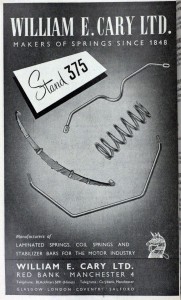
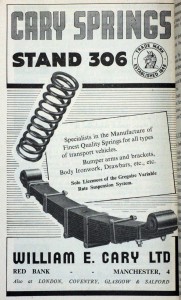 Advertisements of 1951 and 1954
Advertisements of 1951 and 1954
Felt for Fuel tank XK 140
Felt used for fuel tank XK 140
Felt is used between the fuel tank and the chassis & body, but the actual amount, size and position of the various pieces of felt remain unclear from the information in the Service Parts List. Listed are the following items for the XK 140:
The (black) felt used by Jaguar is about ⅛” (or 3 mm) thick and normally 2”(or 50 mm) wide (except C8414 which is 1”or 25 mm wide). The positions of the above pieces of felt:
- Basically the XK 140 fuel tank has 3 felt strips (18” or 45 cm long) placed across the top of the tank front to rear, but the filler opening at the LH side “interferes” with one of these three strips (see 3rd bullet).
- At the LH and RH end of the tank the felt runs from the tank mounting points front to rear over the tank. The RH strip is coded C8373. For the LH strip see 3rd bullet.
- Because the fuel filler opening is placed at the LH side of the tank, the felt strip at this side is not 18” long but had to be cut in two pieces: C8371 and C 8372 with a total length of 16” leaving 2” space for the filler opening.
- The third strip (again C8373) is placed in the centre of the tank parallel to the other strips.
The (original situation) picture below shows where the LH strips went. Black glue was used to hold the strips on to the tank.
 Original
Original ![clip_image002[4] clip_image002[4]](https://www.bobine.nl/jaguar/wp-content/uploads/2013/08/clip_image0024_thumb.jpg) Restored
Restored
![clip_image002[6] clip_image002[6]](https://www.bobine.nl/jaguar/wp-content/uploads/2013/08/clip_image0026_thumb.jpg) The top strips installed on the fuel tank.
The top strips installed on the fuel tank.
There is another 44” (or 110 cm) long and only 1”(or 25 mm) wide felt strip placed along the top of the tank from side to side. This strip is positioned along the front of the top of the tank to protect the tank from rubbing on the chassis cross-member.
![clip_image002[8] clip_image002[8]](https://www.bobine.nl/jaguar/wp-content/uploads/2013/08/clip_image0028_thumb.jpg) Tank in final position including felt strips
Tank in final position including felt strips
Jaguar Identification or Chassis Plates
Overview of Jaguar Chassis Plates used from 1946 to 1974
Jaguar used various types of Chassis (or Identification) Plates in the post WW2 period. The changes in dimension and lay-out of the plates were mostly the result of changes in available space when new models were introduced, but also due to changing brand names of lubricant suppliers or their respective products.
When focusing on the changes related to Chassis Plates we may conclude that the most apparent change relates to size and orientation of the plates in 1948. In the years before a smaller brass plate (Type A, 3½ x 4″) was vertically positioned containing relevant car data and accompanied by a similarly sized plate containing lubricant recommendations.
From the launch of the XK 120 in 1948 the plates were larger and had a “horizontal format” with both car data and lubricant recommendations combined on one plate. The initial size of this plate (Type B, 6½ x 4¼”) as used for the Jaguar Mk V, was apparently too large as it was reduced in October 1949 (Type C, 5¾ x 3¾”).
This then became the standard format for over a decade, with only a change-over from brass to aluminium in 1957.
| Type No | Dimension | Material | Used on | Year |
| TYPE A.1 | 3½ x 4″ | brass | Mk IV | 1946 |
| TYPE A.2 | 3½ x 4″ | brass | Mk IV | – |
| TYPE A.3 | 3½ x 4″ | brass | Mk IV | – |
| TYPE A.4 | 3½ x 4″ | brass | Mk IV and very early Mk V | – |
| TYPE B.1 | 6½ x 4¼” | brass | Mk V, very early XK 120 | 1948 |
| TYPE C.1 | 5¾ x 3¾” | brass | XK 120 | From October 1949 |
| TYPE C.2 | 5¾ x 3¾” | brass | XK 120 | From March 1952 |
| TYPE C.3 | 5¾ x 3¾” | brass | XK 120 | From August 1952 |
| TYPE C.4 | 5¾ x 3¾” | brass | XK 120/XK 140 Manual | From October 1953 |
| TYPE C.5 | 5¾ x 3¾” | brass | XK 140 Auto | 1954 – 1957 |
| TYPE D.1 | 5¾ x 3¾” | alu | XK 150 Manual | 1957 – 1960 |
| TYPE D.2 | 5¾ x 3¾” | alu | XK 150 Auto | 1957 – 1960 |
| TYPE D.3 | 5¾ x 3¾” | alu | XK 140 Manual | only 2nd half 1957 |
| TYPE D.4 | 5¾ x 3¾” | alu | 4XK 150 Auto | only 2nd half 1957 |
| TYPE E.1 | 6½ x 3¾“ | alu | 1961? | |
| TYPE E.2 | 6½ x 3¾“ | alu | ||
| TYPE E.3 | 6½ x 3¾“ | alu | ||
| TYPE E.4 | 6 ½ x 3¾“ | alu | ||
| TYPE E.5 | 6 ½ x 3¾“ | alu | ||
| TYPE E.6 | 6½ x 3¾“ | alu | ||
| TYPE E.7 | 6½ x 3¾“ | alu | ||
| TYPE E.8 | 6½ x 3¾“ | alu | ||
| TYPE E.9 | 6½ x 3¾“ | alu |
Type A plates on Jaguar Mk IV

 Type A4. (?)
Type A4. (?)
Type A plate on a 1948 Mk IV. Plate dimension: 3½ x 4″ . May also have been used on very early Mk V cars. Each of the 3 available engines had a specific plate. The lay-out shows only fields for CHASSIS No, ENGINE No and BODY No and is vertically oriented; all later plates have a horizontal orientation. There may have been 4 text variations for this plate (indicated with A1. to A4.) The recommendations for LUBRICANTS are shown on an identically sized plate next to the Chassis plate: VACUUM, WAKEFIELD, SHELL, ESSOLUBE and PRICE’S are mentioned here.
Type B plates on Jaguar Mk V
This new Chassis Plate measures 6½ x 4¼”, made of brass and plated with nickel. The lay-out has now 4 fields for CHASSIS No, BODY No, ENGINE No and GEARBOX No. The recommendations for LUBRICANTS remained unchanged: VACUUM, WAKEFIELD, SHELL, ESSOLUBE and PRICE’S, but an additional column has been added to show the S.A.E. viscosity. The recommendation from PRICE’S for the WHEEL HUBS was blank. To indicate the VALVE CLEARANCE two new fields have been created to be stamped per car type.
The overall lay-out was the basis for the later Type C plates.
Note: The Mk V manual contains one photo of a car with the smaller ID plate from the Mk IV era.
![clip_image002[4] clip_image002[4]](https://www.bobine.nl/jaguar/wp-content/uploads/2013/05/clip_image0024_thumb.jpg) Type B1
Type B1
Type B plates on Jaguar XK 120 (very early examples)
See data under Mk V. The same plate (Type B1) was used for a number of early XK 120 OTS versions.
Type C plates on Jaguar XK 120
Type C plates were identical to Type B plates but smaller in dimension. Four different Identification plates have been used over the life of the XK 120: C1 to C 4 (with B1 as the fifth variation for the very first XK 120’s).
The first plate (Type C1) showed a blank box for Price’s recommendation for Wheel Hubs lubrication, as was the case with the Type B plate.
![clip_image002[6] clip_image002[6]](https://www.bobine.nl/jaguar/wp-content/uploads/2013/05/clip_image0026_thumb.jpg) Type C1.
Type C1.
This was corrected with a temporary solution by riveting an “add-on” plate over the bottom two rows, now showing BELMOLINE H.M.P. on the empty space. This version (Type C2, see here under) lasted for about 6 months from March to August 1952.
![clip_image004[4] clip_image004[4]](https://www.bobine.nl/jaguar/wp-content/uploads/2013/05/clip_image0044_thumb.jpg) Type C2.
Type C2.
In August 1952 the” add-on” plate was replaced by a new plate (Type C3) fully identical to the Type C1 plate but now with BELMOLINE H.M.P. on the former empty space .
![clip_image006[4] clip_image006[4]](https://www.bobine.nl/jaguar/wp-content/uploads/2013/05/clip_image0064_thumb.jpg) Type C 3.
Type C 3.
Note: also the Jaguar C-type used Chassis Plate Type 3 (see below).
 C-type chassis plate
C-type chassis plate
Final change in Type C plates on Jaguar XK 120 and 140.
In October 1953 a number of modifications were made to the text of the Chassis Plate (Type C 4.). The most important modification was the change from ESSOLUBE to ESSO and BELMOLINE H.M.P. becoming now ENERGREASE No 3. These plates are otherwise easily recognisable by the text change in the VALVE CLEARANCE row, reading INLET and EXHAUST instead of the former abbreviations INL. and EXH..
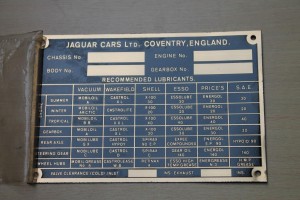 Type C4 (NOS!!)
Type C4 (NOS!!)
Addition of “Automatic” Type C plates on Jaguar XK 140.
From January 1956 onwards an Automatic Transmission was offered for the XK 140, necessitating a change in the lay-out of the Plates. STEERING GEAR and WHEEL HUBS had been combined in one field and the lower row remained blank
 Type C5
Type C5
Type D plates on Jaguar XK 150
This type was introduced in 1957 on the XK 150 and was made of Aluminium instead of Brass as had been the material for all previous types.
The basic lay-out was in line with the Type C5 plates, meaning STEERING GEAR and WHEEL HUBS had been combined in one field and the lower row remained blank.
In addition some Lubricant suppliers had changed name as well as the names for oils and greases themselves. The changes were: MOBIL instead of VACUUM and B.P. instead of PRICE’S.
![clip_image002[8] clip_image002[8]](https://www.bobine.nl/jaguar/wp-content/uploads/2013/05/clip_image0028_thumb.jpg) Type D1
Type D1
![clip_image004[6] clip_image004[6]](https://www.bobine.nl/jaguar/wp-content/uploads/2013/05/clip_image0046_thumb.jpg) Type D2.
Type D2.
Plate for Automatic Transmission has same lay-out as Type C5 except for MOBIL and B.P.
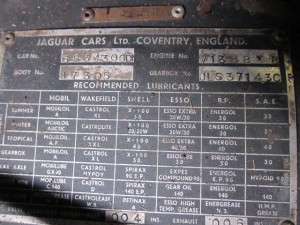
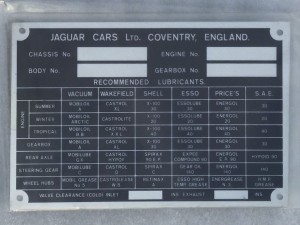 Type D3 with NOS version at the right
Type D3 with NOS version at the right
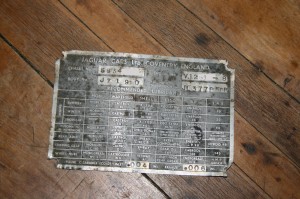 Type D4
Type D4
For a short period a few XK 150’s (without any logical sequence) manufactured from June to November 1957 had a different plate: the row for STEERING GEAR and WHEEL HUBS was no longer combined in one field and the bottom row was now in use. This for both manual (Type D3 plate) and automatic cars (Type D4 plate). It is unclear why this temporary solution had been implemented.
Type E plates on Jaguar E-type
Early E-Types continued the XK150 D style chassis plate. It’s not exactly clear when Jaguar switched over to a new plate but possibly the first 500 cars (with outside bonnet locks) may have carried the D type of chassis plate.
The chassis plate that followed for the E-type was a plate of larger dimension (6½ x 3¾“), which is about ¾ inch wider than the preceding types. The change-over to a larger plate may have been caused by the introduction of 7 rows for lubricant manufacturers instead of 5 plus 1 column for the SAE type of the lubricant. The new row reads: MOBIL. CASTROL, SHELL, ESSO, B.P., DUCKHAM, REGENT CALTEX TEXACO.
Note the little space between TEX and ACO on some plates.
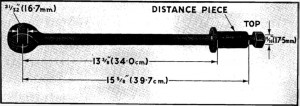
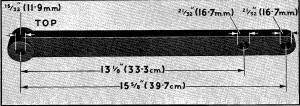
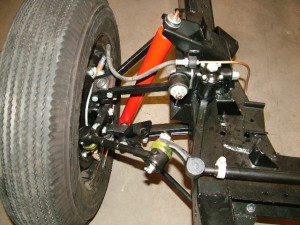
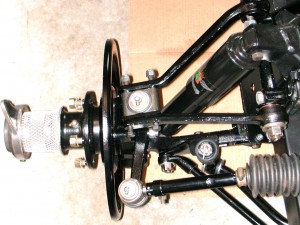
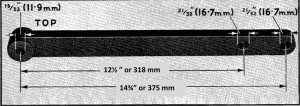
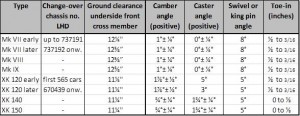
![clip_image002[4] clip_image002[4]](https://www.bobine.nl/jaguar/wp-content/uploads/2014/05/clip_image0024_thumb.gif)

![clip_image002[4] clip_image002[4]](https://www.bobine.nl/jaguar/wp-content/uploads/2014/01/clip_image0024_thumb.jpg)

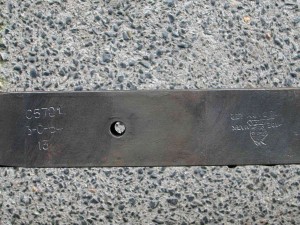
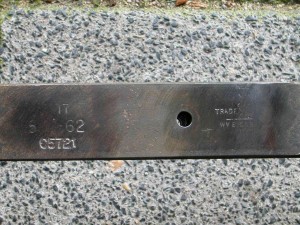


![clip_image006[6] clip_image006[6]](https://www.bobine.nl/jaguar/wp-content/uploads/2013/05/clip_image0066_thumb.jpg)